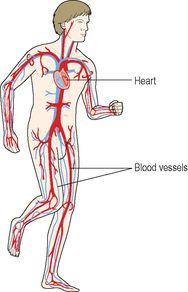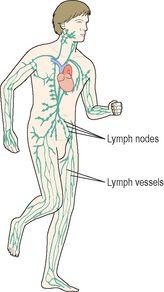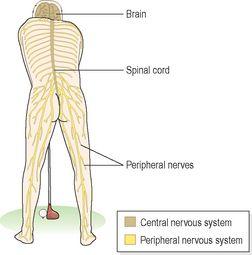Ross & Wilson Anatomy and Physiology in Health and Illness (6 page)
Read Ross & Wilson Anatomy and Physiology in Health and Illness Online
Authors: Anne Waugh,Allison Grant
Tags: #Medical, #Nursing, #General, #Anatomy

Figure 1.7
The circulatory system.
Blood vessels
There are three types:
•
arteries
, which carry blood away from the heart
•
veins
, which return blood to the heart
•
capillaries
, which link the arteries and veins.
Capillaries are tiny blood vessels with very thin walls consisting of only one layer of cells. They are the site of exchange of substances between the blood and body tissues, e.g. nutrients, oxygen and cellular waste products. Blood vessels form a network that transports blood to:
•
the lungs (
pulmonary circulation
) where oxygen is absorbed from the air in the lungs and, at the same time, carbon dioxide is excreted from the blood into the air
•
cells in all other parts of the body (
general
or
systemic circulation
).
Heart
The heart is a muscular sac, which pumps blood round the body and maintains the blood pressure.
The heart muscle is not under conscious (voluntary) control. At rest, the heart contracts, or beats, between 65 and 75 times per minute. The rate is greatly increased during exercise, when body oxygen requirements are increased.
The rate at which the heart beats can be counted by taking the
pulse
. The pulse can be felt most easily where a superficial artery can be pressed gently against a bone. The wrist is the site most commonly used for this purpose.
Lymphatic system (
Ch. 6
)
The lymphatic system (
Fig. 1.8
) consists of a series of
lymph vessels
, which begin as blind-ended tubes in the spaces between the blood capillaries and tissue cells. Structurally they are similar to veins and blood capillaries but the pores in the walls of the lymph capillaries are larger than those of the blood capillaries.
Lymph
is tissue fluid that also contains material drained from tissue spaces, including plasma proteins and, sometimes, bacteria or cell debris. It is transported along lymph vessels and returned to the bloodstream.
Figure 1.8
The lymphatic system:
lymph nodes and vessels.
There are collections of
lymph nodes
situated at various points along the length of the lymph vessels. Lymph is filtered as it passes through the lymph nodes, and microbes and other materials are removed.
The lymphatic system (
Ch. 6
) also provides the sites for formation and maturation of
lymphocytes
, the white blood cells involved in immunity (
Ch. 15
).
Internal communication
This is carried out through the activities of the nervous and endocrine systems.
Nervous system (
Ch. 7
)
The nervous system is a rapid communication system. The main components are shown in
Figure 1.9
.
Figure 1.9
The nervous system.
The
central nervous system
consists of:
•
the
brain
, situated inside the skull
•
the
spinal cord
, which extends from the base of the skull to the lumbar region and is protected from injury by the bones of the spinal column.
The
peripheral nervous system
is a network of nerve fibres, which are:
•
sensory
or
afferent
nerves that transmit signals from the body to the brain, or
•
motor
or
efferent
nerves, which transmit signals from the brain to the effector organs, such as muscles and glands.
The
somatic
(
common
) senses are pain, touch, heat and cold, and they arise following stimulation of specialised sensory receptors at nerve endings found throughout the skin.
There are different receptors in muscles and joints that respond to changes in the position and orientation of the body, maintaining posture and balance. Yet other receptors are activated by stimuli in internal organs and control vital body functions, e.g. heart rate, respiratory rate and blood pressure. Stimulation of any of these receptors sets up impulses that are conducted to the brain in sensory (afferent) nerves.
Communication along nerve fibres (cells) is by electrical impulses that are generated when nerve endings are stimulated. Nerve signals travel at great speed, so response to a nerve signal is almost immediate, making rapid and fine adjustments to body functions possible.
Communication between nerve cells is also required, since more than one nerve is involved in the chain of events occurring between the initial stimulus and the reaction to it. Nerves communicate with each other by releasing a chemical (the
neurotransmitter
) into tiny gaps between them. The neurotransmitter quickly travels across the gap and either stimulates or inhibits the next nerve cell, thus ensuring the message is transmitted.
Sensory nerves send signals from the body to the appropriate parts of the brain, where the incoming information is analysed and collated. The brain responds by sending signals along motor (efferent) nerves to the appropriate effector organ(s). In this way, many aspects of body function are continuously monitored and adjusted, usually by negative feedback control, and usually without conscious awareness, e.g. regulation of blood pressure.
Reflex actions
are fast, involuntary, and usually protective motor responses to specific stimuli. They include:
•
withdrawal of a finger from a very hot surface
•
constriction of the pupil in response to bright light
•
control of blood pressure.
Endocrine system (
Ch. 9
)
The endocrine system consists of a number of discrete glands situated in different parts of the body. They synthesise and secrete chemical messengers called
hormones
that circulate round the body in the blood. Hormones stimulate
target glands
or
tissues
, influencing metabolic and other cellular activities and regulating body growth and maturation. Endocrine glands detect and respond to levels of particular substances in the blood, including specific hormones. Changes in blood hormone levels are usually controlled by negative feedback mechanisms (see
Fig. 1.4
). The endocrine system provides slower and more precise control of body functions than the nervous system.
Communication with the external environment
Special senses (
Ch. 8
)
These senses arise following stimulation of specialised sensory receptor cells located in sensory organs or tissues in the head. The senses and the special organs involved are shown in
Box 1.2
.
Box 1.2
The special senses and related sense organs
Sight – eyes
Hearing – ears
Balance – ears
Smell – nose
Taste – tongue
Although these senses are usually considered to be separate and different from each other, one sense is rarely used alone (
Fig. 1.10
). For example, when the smell of smoke is perceived then other senses such as sight and sound are used to try and locate the source of a fire. Similarly, taste and smell are closely associated in the enjoyment, or otherwise, of food. The brain collates incoming information with information from the memory and initiates a response by setting up electrical impulses in motor (efferent) nerves to effector organs, muscles and glands. Such responses enable the individual to escape from the fire, or to prepare the digestive system for eating.





